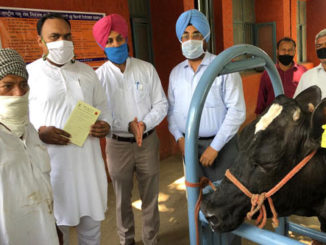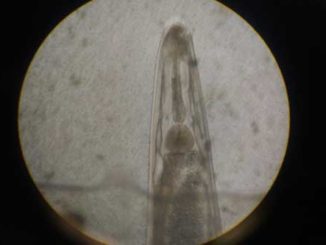Lymph nodes are bean shaped small lymphoid glandular structures. Lymph nodes are usually considered as important organs where diseases and abnormalities are most likely to produce visible or palpable lesions. Lymph nodes functions as filters for different micro-organism and abnormal or toxic chemicals in the tissues fluid of the body. The major lymph nodes are located in specific places and fluids draining through them come from specific areas of the body. The lymph node and tissue responses will indicate the location and severity of the condition, whether or not the disease has begun to spread through the body. Various aetiological factors are involved in the pathology of lymph nodes; in some cases the cause is obvious, in others obscure.

Lymph node affection may be focal, regional or generalized, or the first two types may progress to the third. There may be generalized or localized enlargement. Infectious causes of generalised lymph node enlargement in cattle include tuberculosis, brucellosis, protozoal infection. It is transient in most young animal, mesenteric lymph node of intestine. It is considered localized if only one lymph node is enlarged where the disease condition is within the drainage field of that node (inflammation, neoplasia). Localized adenopathy should prompt a search for an adjacent precipitating lesion and an examination of other nodal areas to rule out generalized lymphadenopathy. The Lymphadenopathy may be the only clinical sign of disease or it may be accompanied by various signs and symptoms like pain, fever, several nonspecific findings. The detection of swollen lymph nodes will often raise the image of severe diseases.
Lymph node pathology includes infection, inflammation (lymphadenitis) which can be acute or chronic; granulomatous or casseous, hyperplasia, and neoplasia. Hyperplastic lymph nodes may occur as a benign, non-neoplastic reactive response to immune stimulus. It is characterized by increased number of B-lymphocyte, T-lymphocyte or both. In cattle, there are various disease which is associated with lymph node affections viz, viral disease (bovine viral diarrhoea, Enzootic bovine leukosis), bacterial disease (bovine tuberculosis, Johne’s disease, caseous lymphadenitis), parasitic disease (bovine theleriosis) and cancer.
Various disease conditions associated with lymph node affections are summarized as follows:
Viral Disease
A. Bovine Viral Diarrhea
Bovine viral diarrhoea (BVD) also known as mucosal disease (MD) is caused by BVDV, a Pestivirus. Cattle are the natural host. BVDVcauses persistent infections (PI) and preferentially infects cells of the immune system, including macrophages, DCs, and lymphocytes. Erosive lesions are observed in the nares and in the trachea, as well as throughout the upper and lower alimentary system. The abomasum and intestine shows erosions, hemorrhages, ulceration. Petechial hemorrhages are found in the cortex of the kidneys, on the ureters, and within enlarged lymph nodes. The associated lesions in lymphoid tissues are severe lymphoid depletion in mesenteric lymph nodes and Peyer’s patches. Histologically, there is marked lymphocytolysis and necrosis of germinal centers in Peyer’s patches and cortices of lymph nodes. There is thymic atrophy because the thymus is markedly depleted of lymphocytes and may consist of only collapsed stroma and few scattered lymphocytes.
B. Enzootic Bovine Leukosis (EBL)
Enzootic bovine leukosis (EBL) also called bovine lymphosarcoma or bovine leukemia, is an infectious disease naturally occurring in cattle caused by bovine leukemia virus (BLV). The virus infects lymphocytes (preferentially B lymphocytes) and integrates a DNA intermediate as a provirus into the genome of the cells. So spread of virus occurs on exposure to biological fluids contaminated with infected lymphocytes. It can be transmitted either vertically (about 10% of calves born to BLV-infected dams are already infected at birth), or horizontally (blood, milk/colostrum, saliva) or iatrogenically (e.g., rectal sleeves, instruments/equipment).
Enzootic bovine leukosis is characterized by a long incubation period and a variety of clinical outcomes. Almost 70% of BLV-infected animals are asymptomatic carriers so are aleukemic, do not present clinical and/or hematological manifestations of the disease. Approximately 30% of infected cattle develop a non-malignant polyclonal B lymphocyte lymphocytosis which is characterized by an increase in the number of peripheral blood circulating B-lymphocytes (above 10,000/mm3). During persistent lymphocytosis, animals may suffer from immunological dysregulation, as evidenced by opportunistic infections (e.g., mastitis). Less than 5% of BLV-infected animals develop malignant B-cell lymphosarcoma, which occurs between 1 and 8 years after infection. Grossly multiple tissues may be affected in cattle that develop lymphoma, including peripheral lymph nodes (cephalic, cervical, sublumbar) (abdominal lymph nodes, retrobulbar region, abomasum, liver, spleen, heart, urogenital tract, bone marrow, vertebral canal , and spinal cord. Most of the high-grade lymphomas may be either diffuse large cell lymphomas or intermediate cell lymphomas (Burkitt-like and lymphoblastic lymphomas).
Bacterial Disease
A. Bovine Tuberculosis
Bovine Tuberculosis (bTB) is a chronic disease in cattle caused by Mycobacterium bovis, a member of the Mycobacterium tuberculosis complex (MTBC). The bacilli cause initial infection or primary complex formation at portal of entry (lungs) and regional lymph nodes (trachea-bronchial and mediastinal lymphnode). If infection is not contained within this primary complex, bacilli disseminate via lymph vessel to distant organs and other lymph nodes by infected macrophage. There is presence of many caseated granulomas with calcified centers, in pleura, peritoneum (hence named pearl disease) and lymphnodes. Enlarged trachea-bronchial lymph nodes contribute to dyspnea by impinging on airways, and the enlargement of caudal mediastinal nodes can cause bloating by compressing the caudal thoracic esophagus.
B. Johne’s Disease
Johne’s disease is infectious, incurable, chronically progressive granulomatous enteritis affecting domestic and exotic ruminants and is caused by Mycobacterium avium subsp. Paratuberculosis. It primarily affects the intestinal tract and associated lymph nodes (ileal and mesenteric lymph nodes) in ruminants. The main characteristic lesions in cattle include non-caseating granulomatous enteritis usually confined to the ileum, cecum, and proximal colon; lymphangitis; and lymphadenitis of regional lymph nodes. Histologically in the ileocecal lymph nodes there are aggregates of epithelioid macrophages and multinucleated giant cells with acid fast bacilli inside it.
C. Pseudotuberculosis or Casoeus Lymphadenitis
It is a chronic contagious disease of small ruminants and lesser in cattle. The disease is caused by Corynebacterium pseudotuberculosis. It is characterized by formation of caseous abscess in superficial lymphnodes and/ or internal lymph nodes and organs. The lesions in the lymph nodes showed laminated central area of necrosis surrounded by thin layer of macrophages, epitheliod cells mixed with neutrophils and lymphocytes surrounded by fibrous connective tissue.
D. Contagious Bovine Pleuropneumonia (CBPP)
It is a highly contagious disease of ruminants caused by Mycoplasma mucoides subsp mycoides SC. It is characterised by fever, respiratory signs, nasal discharge in cattle. Lesions are generally restricted to the chest cavity except arthritis in young calves. The lesions are mostly confined usually to only one lung and its pleura. In most cases, only the diaphragmatic lobe is involved. It is firm and fleshy, resembling liver more than healthy pink lung, and does not collapse as normal when the chest is opened. In acute case there is presence of yellowish fluid in the chest cavity, fibrin around the lungs whereby the lungs adhere to the chest wall.The cut surface of the lung often shows a marbled appearance with areas of different colour (dark red, red and pale pink) separated by a network of pale bands, which is the typical feature of CBPP. In the chronic form, fluid is rarely seen in the pleural cavity but adhesions between lung lobes and between lungs and the chest wall are commonly found. Areas of dead lung tissue become surrounded by a capsule of fibrous connective tissue. This structure is called a sequestrum. Various intermediate stages between the acute lesion and a fully formed sequestrum can be found depending on the stage of the disease. In CBPP, bronchial lymph nodes are aminly affected. It may be enlarged and oedematous, with small necrotic foci and pin-point haemmorrhages, the difference between cortex and medulla may be indistinguishable. Sequestra may also be observed in lymph nodes.
E. Actinobacillosis
Actinobacillosis is a specific infectious disease of mainly cattle and sheep caused by a gram-negative coccibacilli, Actinobacillus lignieresii. In cattle, actinobacillosis mainly affects the tongue (‘wooden tongue’) and the lymph nodes of the head and neck. The characteristic lesion is a granuloma of the tongue, with discharge of pus containing small, hard yellow to white granules to the exterior. Infection usually begins as an acute inflammation with sudden onset of inability to eat or drink for several days, profused salivation , painful swelling of tongue followed by nodules and ulcers on the tongue. Animals may occasionally die from starvation and thirst in the acute stages of the disease. As the infection becomes chronic, fibrous tissue is deposited and the tongue becomes shrunken and immobile and eating is difficult. Encapsulated abscesses may be found in local lymph nodes and discharge creamy pus, which may contain granules.
F. Brucellosis
In cattle, brucellosis is caused by Brucella abortus which is characterized mainly by abortion during the last trimester of gestation, infertility and reduced milk production in females, and infertility, orchitis, and epididymitis in males. In ruminants, Brucella has a marked affinity for lymphoid and reproductive organs. It replicate to high numbers in the gravid uterus and also infect the udder and lymph nodes of the inguinal and head regions, respectively. In non-pregnant and persistently infected cows, the udder and supramammary lymph node are the most common sites for localization. In the acute brucellosis form, lymph node changes have been characterized as lymphocytic hyperplasia in the cortical and paracortical zone with disappearance of lymphoid follicles and corticoparacortical junctionl. In the chronic brucellosis form, granuloma are foremed in the lymph node (Bang Granuloma). The lymph node changes are characterized by granulomatous lymphadenitis with the presence of giant cells that are dispersed within a stroma invaded by hyperactivated epithelial cells or macrophages delimited by a massive infiltration of lymphocytes. Central necrosis, disappearance of cortical and paracortical structures are observed.
Parasitic Disease
A. Tropical Theleriosis
Tropical theleriosis is a tick borne protozoal disease of cattle and buffaloes causing high mortality, morbidity as well as production losses in tropical and subtropical regions. Theileria annulata is the causative agent with Hyalomma as the tick vector. The affected animals show fever, anemia, prominent enlargement of superficial lymph node, anorexia and progressive loss of body weight. Infective sporozoite stage (ticks) after entry invade lymphocyte within few days develop to schizont, that disseminate through lymphoid system. Finally piroplasm infected RBCS taken up by vector tick.The diagnosis of theileriosis is usually made by direct detection of piroplasms and schizonts in blood smear and/or lymph node smears along with clinical signs of disease like high fever and enlargement of lymph nodesIn acute phase more than 60% lymphocyte contain schizonts (Koch’s Blue Bodies).There is wide spread lympholysis with general loss of small lymphocytes, with those that remain appear large and blastics.Germinal center remain prominent and surrouned by areas of haemorrhage.
Fungal Disease
In cattle, Lymph nodes affections are of granulomatous lymphadenitis and occur mainly in the mesenteric lymph nodes. Mycotic infections are usually zygomycosis which is an opportunistic fungal infection caused by the fungi that used to belong to the class Zygomycetes (Mucor, Rhizopus and Absidia sp). Zygomycetes, such as Mucor pusillus and Lichtheimia corymbifera, are members of normal rumen flora and infection can occur with a disruption of the normal balance between animals and agents, which has been associated with several factors, such as ruminal acidosis and broad-spectrum antimicrobial drugs that affect the normal flora in the fore-stomachs.
Affected lymph nodes are enlarged (2 to 42 cm in greatest dimension), firm, and mottled gray-white to yellow with multiple granular or caseocalcareous foci. Histologically, the lymph node showed necrotizing granulomatous inflammation characterized by necrosis, mineralization and fibrosis with infiltration of eosinophils, macrophages, neutrophils, lymphocytes and multi-nucleated giant cells along with filamentous fungal hyphae.
Cancer
A. Sporadic Lymphoma
Besides, lymphoma due to bovine leukemia virus (BLV), there are three sporadic lymphomas which occur in cattle. These include (a) calf sporadic bovine lymphoma which is characterised by symmetrical generalized lymph node enlargement and leukemia in calves from 3 to 6 months of age; (b) the juvenile/thymic form that affects the lymph nodes and thymus characterized by large cranial thoracic/lower cervical masses, respiratory distress, and weight loss in cattle less than 2 years of age; (c) the cutaneous form, more common in animals about two years old characterized by plaque-like, round raised skin lesions, often with ulceration typically located on the head, sides, and perineum.
B. Secondary Lymphoma
Lymph nodes often become enlarged owing to the presence of metastatic deposits of carcinoma and other malignant tumours but sometimes the metastatic deposits, may also occur in lymph nodes without enlargement.
Diagnosis of Lymph Adenopathy
A proper history of the animals is required regarding any signs and symptoms suggestive of infection or any disorders or any medications. Physical examination of the animals should be done to detect any changes in the lymph nodes. When lymphadenopathy is localized, the clinician or Veterinarian should examine the regional draining lymph nodes for evidence of infection, skin lesions or tumors. Other nodal sites should also be carefully examined to exclude the possibility of generalized rather than localized lymphadenopathy. Generalized adenopathy should always prompt further clinical investigation. If lymph nodes are detected, the following five characteristics such as size, pain/tenderness, consistency, matting (a group of nodes that feels connected and seems to move as a unit) and location should be noted. In animal with generalized lymphadenopathy, the physical examination should focus on searching for signs of systemic illness.
Further, a complete blood count (CBC) may help evaluate the overall health condition of the animal and detect a range of disorders, including infections and leukemia. Ultrasonography or radiology (X-ray) or scan of the affected area may help determine potential sources of infection or find tumors. When cytological analysis of the lymph node aspirates or lymph node biopsy is indicated, fine needle aspirates or excisional biopsy of the most abnormal node will help to determine a diagnosis.
By histopathology, typical characteristic features of the lesions could help to diagnose a disease such as granumatous inflammation (Tuberculosis), casseous lymphadenitis (Corynebacterium pseudotuberculosis), The causative agents can be detected in the tissue itself through special staining such as Gram’s stain for bacteria, Zeihl Nelseen’s stain for Mycobacterium, Grocott-Gomori’s methenamine silver stain for fungus etc. Further the agents can also be detected using specific antibody against the causative agent through immunohistochemical (IHC) technique. The IHC results with clinical features and cytologic findings before arriving at the final diagnosis.
Further culture of the fluid from the lymph node in suitable culture media for either bacteria or fungi will provide information on which types of organisms are involved in the disease. Serological testing (ELISA) is useful for detection of antibodies for viral and bacterial agents. Various molecular diagnostic techniques (PCR, realtime PCR) can be used for the diagnosis of various agents like BLV, Mycobacteria, Theleria, fungus etc.
Suggested readings
- The pathologic basis of Veterinary Disease by Zachary JF and McGavin MD, 6th Edition, 2017, Elsevier.
- Veterinary Pathology by Ronald Duncan Hunt, Thomas Carlyle Jones and Norval W. King, 6th Edition (1 March 1997) Wiley-Blackwell.
- Jubb, Kennedy and Palmer’s Pathology of Domestic Animals, edited by Grant Maxie (2015) 6th Edition, Saunders Ltd.






Be the first to comment